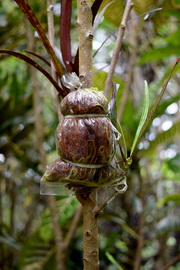
Study Shows Natural Genetic Engineering in Grafted Plants
April 12, 2017| |
 Rutgers University researchers led by Pal Maliga reported that grafted plants exchange mitochondria, the powerhouse of the cells which contain their own genomes. Furthermore, when the whole mitochondria from one plant get into the cells of another, they combine their DNA with that of the existing mitochondria. These findings, published in PNAS, show that farmers from all over the world who graft plants have been doing unintentional genetic engineering.
Rutgers University researchers led by Pal Maliga reported that grafted plants exchange mitochondria, the powerhouse of the cells which contain their own genomes. Furthermore, when the whole mitochondria from one plant get into the cells of another, they combine their DNA with that of the existing mitochondria. These findings, published in PNAS, show that farmers from all over the world who graft plants have been doing unintentional genetic engineering.
Maliga and team grafted one tobacco species onto another. One species had a mutation in the mitochondria that inhibits the normal development of male flower parts. Then the researchers took slices of the sterile-male portion of the plant and grew whole plants from them. Some of these plants produced flowers with normal male parts indicating successful mitochondrial transfer between the two species. Swapping of genomes was found to occur in areas close to the graft, but new shoots usually form in this region. These new shoots grow into new plants with mixed genomes.
Get more details from PNAS and New Scientist.
| |
Biotech Updates is a weekly newsletter of ISAAA, a not-for-profit organization. It is distributed for free to over 22,000 subscribers worldwide to inform them about the key developments in biosciences, especially in biotechnology. Your support will help us in our mission to feed the world with knowledge. You can help by donating as little as $10.
-
See more articles:
-
News from Around the World
- 108 Million People Face Severe Acute Food Insecurity – Report
- Development of New Tool to Estimate GM Pollen Spread
- Untangling Molecular Mechanisms Connecting Plant Stress and Growth
- Scientists Aim to Develop Crops that Require Less Labor
- Study Shows Natural Genetic Engineering in Grafted Plants
- New Biosafety Guidelines Introduced to Stakeholders in Cebu, Philippines
- EFSA Publishes Scientific Opinion on Three-Event Stack Oilseed Rape by Monsanto and Bayer
-
Research Highlights
- Identification of Gene Associated with Cold Tolerance at the Seedling Stage in Rice
- Mutant Rice Plants with Low Gibberellin Produce High Yield and Stress Tolerance
-
Beyond Crop Biotech
- Gene Mutation Found in ‘Night Owls'
- Genes that Give Cannabis its Flavor
-
Announcements
- 14th Annual BIO World Congress on Industrial Biotechnology
- March for Science
-
Resources
- The Petri Dish is Now Online
-
Plant
- Review of the Impacts of Genome Editing Techniques in Plants
-
Read the latest: - Biotech Updates (December 17, 2025)
- Gene Editing Supplement (December 17, 2025)
- Gene Drive Supplement (February 22, 2023)
-
Subscribe to BU: - Share
- Tweet
